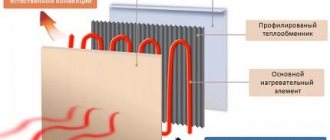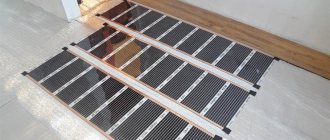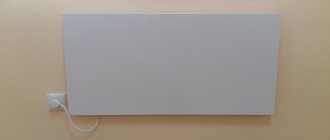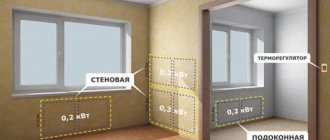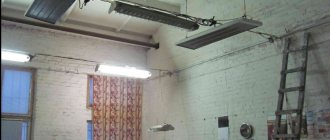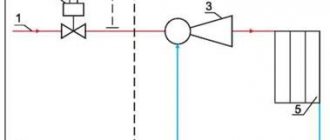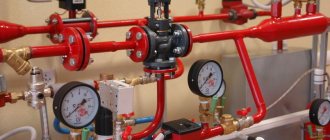IR heaters today are stylish, fashionable, practical and efficient. This type of climate control equipment is extremely economical in terms of electricity consumption, and its design allows you to quickly start heating the room. In addition, the IR heater does not dry out the air.
The versatility of using this type of heater is another advantage that can be realized when installing it in any room. Today, IR heaters can be found in any form, which allows you to expand the choice for a potential buyer.
In this article we will tell and show IR panel heaters and which ones are best to choose.
TOP 7 IR heaters
Information on infrared heating
Infrared thermal panels are direct heaters. The technology is based on the use of light waves from the region below the visible region of red light (long infrared waves IR-C*). This heat can be compared to the sun's rays. Infrared radiation is completely natural and safe. Moreover, it works well for consumers (used in maternity hospitals for many years). The most visible source of infrared heat wave is, of course, the Sun. Using room heating based on infrared heating panels, you bring a small solar home! The waves emitted by the panels reach the body without heating the air, creating a feeling of soothing warmth and comfort.
Infrared radiation waves are divided into three types: short wavelengths near visible light IR-A (>700°C), medium wavelengths IR-B (about 250–700°C) and long wavelengths IR-C (<250°C). A person is able to sense infrared heat waves when the temperature of a given object is above 22°C, but, of course, the higher the surface temperature, the greater the susceptibility of the heat wave.
Types of electrical appliances
Since using centralized heating is not the best solution, the best option would be to use electrical appliances. One of three devices is suitable for balconies: fan, convector and oil heater. It is worth considering the features of each device, advantages and disadvantages.
Fan heater
The thermal ventilation system is a compact device that allows you to heat a room in a short time. This device includes a housing made of plastic, a fan that blows out heat and a tubular electric heater itself. When electricity is supplied to the heating element, it warms up. Then, the fan supplies cold air to it and, as a result, the heated gas enters the balcony.
Fan heater
The heating rate is quite high. However, it is impossible to use them on an ongoing basis. Therefore, they are not the optimal choice.
Convector heater
The operating principle of these types of heating elements is based on the physical phenomenon of convection. The heater allows you to warm up the room in a short time due to the flow of warm air. This type of device has many advantages:
- High rate of room heating.
- Low noise level during operation.
- The kit includes a number of sensors that constantly maintain the set temperature.
- Protected from overheating.
- Can be easily moved from place to place.
Convector
The disadvantages of this type of device include drying out the air. This significantly reduces the relative humidity, which is harmful to the eyes. In addition, breathing too dry air can cause severe headaches. The energy consumption of convectors is very high.
Oil heater
Heaters powered by oil are designed for heating rooms with small dimensions, up to 25 square meters. This is enough even for large loggias. Typically, devices are made in a metal case, inside of which mineral oil is placed. When electric current is supplied, the thermal element transfers energy to the oil, which heats the segments of the device. As a result, heat is transferred into the room.
Oil heater
Oil has a significantly higher thermal conductivity than water. But, the heating rate of this type of device is much lower than its analogues. However, the cooling rate of the device is also low, so after maximum heating, the oil radiator will continue to warm for a long time.
Oil radiators are considered safe for the environment and residents. They are usually equipped with overheat sensors. If the temperature of the mineral oil reaches 80 degrees, the device is activated.
Oil radiators have the following disadvantages:
- During operation, a significant amount of electricity is consumed.
- For normal operation of the device, reliable heat insulation must be ensured. Otherwise, due to constant blowing, the device will not be able to heat the room.
Heat waves emitted by infrared panels
In the case of traditional heating, according to the principle of air circulation in the room, the heat increases. Therefore, the space under the ceiling heats up more than on the floor. In the case of infrared heating, walls, objects and people heated by the thermal infrared panels generated by the heat release the accumulated heat, thereby achieving thermal comfort throughout the room with an even temperature distribution.
Unlike traditional heating systems, infrared thermal panels do more than simply heat the air in a room. The infrared waves emitted by our devices generate heat when they come into contact with the surface of a wall, object or body. After contact with infrared waves, heat is absorbed by an object and then slowly released into the environment while being reflected to other objects, which also absorb it. As a result, users can be said to be dealing with two types of heat:
- Direct (radiation) – emitted by panels;
- Indirect (radiation) – emitted by surfaces and objects.
This enhances the effect of uniform temperature distribution in the rooms. Thanks to this, we get rid of the feeling of “cold feet” and “hot heads”. In turn, the heated walls remain dry over the entire surface. Thanks to this, you can further eliminate the moisture problem and prevent the development of mold and mildew. By drying the walls, improve their insulation properties (a dry wall is better insulated due to lower thermal conductivity than a wet wall), thereby reducing the need for heat.
Selection rules
Using such devices is a more efficient way to heat your own home. But you need to know how to choose the right equipment. First of all, you need to decide for what purpose the device will be used.
If you need a model that will be the main source of heating, then first of all you should pay attention to power. It is desirable that the device have at least 100 W/sq.m. If in a city apartment the ceiling height is more than 3.5 m, then you need to focus on the norm of 120-130 W/sq. m.
You should approach the choice of panels more carefully, based on your needs
There are other factors that may influence the selection of an infrared heating device:
- Walls in the room. Their type, as well as the presence of insulation structures on their surface.
- Glazing quality. It matters here what type of windows are installed in the openings, how effectively the sashes are pressed against the frame, and whether the products contain energy-saving glass.
- Ceiling characteristics. What is the condition of the ceiling, what is located on top - another apartment or a roof.
All these factors have a significant impact on heat loss in the room.
The advantage of infrared panels
In the case of heating with infrared thermal panels, noticeable thermal comfort is achieved at temperatures approximately 2–3°C lower (than in the case of convection heating). Thanks to this you can achieve cost savings of 10%, for example a room with a measured temperature of 18°C will feel around 20–21°C. We will feel a similar effect on a hot day under the rays of the sun - when we return to the shade, we immediately become colder, despite the same air temperature in the sun and in the shade. As the temperature decreases, the amount of heat transferred through the space decreases due to the smaller difference in temperature between inside and outside, thereby reducing heat loss during air exchange (through stomata, barrels).
Behind the above there is another advantage, that is, an increase in air humidity associated with a decrease in its temperature. In such conditions, the mucous membranes (the body's natural defense against colds) do not dry out, especially in winter. Not using traditional convection heat indoors prevents the growth of dust, pollen, bacteria and other particles, which is especially important for sensitive people or those with allergies. As you can see, a favorable microclimate is created in an infrared heated room.
The operation of infrared thermal panels can be compared to the operation of a good old tiled stove, which also transfers heat without the participation of air and therefore without emissions. The cozy warmth of such a stove consisted of two factors: the crisp, still and dusty air and the warm walls. A tile stove, usually located on the inside wall of a room, can radiate heat evenly to all walls. The intense heat radiation from the furnace heated the interior walls, leaving the air in the room cold.
Scientific research shows that people in a room with high air temperature and cool walls will feel cold, and in a low air temperature but with warm walls, they will be warm.
Savings associated with the use of infrared heating panels:
- Long service life of thermal panels, trouble-free and waste-free operation - eliminating the cost of replacing the heating system in just a few years;
- No system maintenance costs – heating panels do not require periodic maintenance and inspections such as a chimney or furnace;
- Energy efficiency - there is no heat loss, as when it is transported through pipes from the furnace to the radiators, and also high efficiency (more than 98% of electricity is converted into heat). Compared to traditional heating methods, we can count on cost savings of up to 30% during the heating season, and up to 60% during transition seasons!
- Relatively low purchase cost and ease of installation - there are no high costs for the purchase and installation of a convection system. An infrared heating system will typically be 30-50% cheaper;
- Saving space in the building - there is no need to allocate space for storing fuel or a room for the stove.
Features of infrared heating panels:
- Efficient (up to two times more efficient than other heating systems);
- Environmental friendliness (no energy loss, no emissions - they perfectly complement each other with solar panels);
- The device is easy to assemble (without high installation costs, taking into account the plumber or pipes);
- Universal fastening (the panels can be installed on the wall or ceiling, saving space);
- Adaptation of devices to the individual character of the interior or the purpose of the room (you can choose the color of the panels or place the selected pattern on them; options for panels with a glass surface or in the form of a mirror are also available);
- Almost instantaneous heating effect (the panels heat up quickly, within a few minutes);
- There are no system maintenance costs (no need for periodic maintenance and inspection of heating panels);
- High quality and durability of the devices, which is reflected in the 5-year warranty and compliance with CE certificates;
- Flexibility of using heating panels - can be used in one room, difficult to heat, or as a general heating system;
- Convenience and ease of use – the ability to use various thermostats (wired and wireless) and heat individual zones;
- Elimination of condensation (condensation), elimination of moisture and mold in the room;
- There is no convection (air movement) and drying of the room;
- Eco-friendly - ideal for people with allergies (no dust in the air), does not create noise or odor.
Selection of infrared heaters
The best results in energy savings will be obtained by using "excess power" because stronger panels reach the set temperature faster and turn off earlier, resulting in lower energy consumption (reduced operating time of heating devices). A properly selected infrared heat panel should not be turned on for more than 6 hours a day to maintain a favorable room temperature on frosty days. The costs of purchasing the panels are one-time, but the operating savings are achieved over many years.
Taking into account the economic aspect of heating using infrared thermal panels, the building's heating power requirement from the panels should be calculated according to the principle:
A).30-35 W / 1 m³ for the main heating system (30 W - the building is well insulated, 35 W - in the absence or insufficient insulation of the building),
B).12-15 W / 1 m³ for an autonomous heating system (when using an additional heating system).
Quality of sales and prospects for the development of solar technologies
The modern market and its sales technologies do not leave the buyer with an unambiguous assessment. Especially high-tech equipment and devices. This also applies to the market for the sale of solar power supply systems. Since production technologies themselves are very energy-intensive, if you want to purchase solar panels or buy a solar power plant for your home, the price in both cases will call for a detailed analysis not only of technical and technological features, but also of economic justification.
Voltage stabilizers for the home: reviews. Which converter is better to choose?
Main technical characteristics of devices. Review of modern models. Connection and repair of rectifiers.
An important factor when purchasing FSE is the quality of sales services. If by the price of a product we understand only its check face value, then by cost we can, within the framework of the article, also agree to understand all types of overhead costs, the reliability of the seller and the product, as well as the cost of time and moral strength.
Thus, the cost of solar panels for a home or the cost of a set of solar power plants for a home from the same manufacturer can differ significantly from different sellers. The reason may be as follows:
- The seller does not carry out preliminary engineering calculations. This means you need to go elsewhere. And this is time and transport;
- the seller does not carry out design work. You will have to spend money, use additional time and transport;
3D diagram of solar panel installation
The seller does not have some components. You will again have to look for the product in another store, which may be more expensive and will again require additional time and transportation; The seller simply does not have installation teams to install the equipment. Time costs again; the seller does not deal with logistics
This means that a situation is possible when everything will be assembled, but one important element will have to wait an unknown number of days. And so on.
Helpful advice! Choose a seller with a full package of services, ranging from assistance in the project, high-quality equipment in the provision of professional installers to warranty service.
The future belongs to alternative energy sources
The rapid penetration into our lives of new technologies for the use of alternative sources of electricity and heat directs our choice to increasingly purchase solar power plants, solar collectors (heating stations), domestic wind and hydroelectric power stations, as well as to use heat pumps and a variety of electric generators. Thus, in recent years, significant experience has been gained in the use of photovoltaic power supply systems in many areas of business. This applies to the use of solar panels and solar collectors in domestic conditions: in private homes and dachas.
The use of solar energy is the optimal solution for home and garden
In conclusion, we can say that the solar technology market currently offers a wide range of different equipment. And most importantly, taking into account the reasonable cost of solar panel kits for the home, reviews of their high quality and long period of reliable operation, we can conclude that the use of this equipment is becoming more feasible and allows participation in large-scale environmental projects and programs.
Application of infrared panels
Heated thermal panels work well in a wide range of applications. Examples:
- heating of apartments, houses, holiday homes, winter gardens;
- heating of offices, conference rooms;
- heating of shops, service points, trading areas;
- heating of halls, warehouses, workshops, loading ramps;
- heating of exhibition and exhibition halls;
- communal heating;
- heating schools, kindergartens,
- heating of museums and galleries;
- heating of catering establishments;
- heating of hotels, sanatoriums, shelters;
- heating of hospitals and sanatoriums;
- heating of churches and places of worship;
- heating of sports halls, entertainment halls, sports halls;
- heating in zoological and botanical gardens;
- heating in livestock and crop production;
- heating in saunas, swimming pools and fitness clubs and much more.
Types of devices
According to the fuel used, heaters are divided into:
- electrical;
- gas;
- diesel
The last two types are not used for home use. Their function is to heat large areas and utility rooms. Therefore, exclusively electric models can be used to heat balconies and loggias. Depending on the type of heater, the following types are distinguished:
- Ceramic, in which the heater is a dielectric placed in a ceramic panel that transmits infrared radiation. This type of device is usually mounted.
- Carbon heaters are more modern models. The heating element is a quartz tube filled with carbon fiber. The devices are distinguished by high efficiency and also cost.
- In film devices, the heating element is usually a flexible cable with a high level of resistance, which heats the metal film. Such devices are installed on prepared foundations. They are highly flexible, so you can give them the desired shape.
Conclusion
A heating system based on infrared thermal panels is the optimal solution for all types of health centers. This is the additional value that can be offered to the customer, lower installation and heating costs, better and healthier well-being. Long infrared waves help improve the circulatory system, strengthen the immune system, have a positive effect on rheumatoid arthritis, increase the stretch of collagen tissue, reduce joint stiffness and reduce muscle spasms.
Radiator or heater
The heating device can be selected only after the balcony is completely insulated. Without glazing, thermal insulation and a heated floor system, it will be difficult to retain heat on the balcony. However, to ensure the heat supply you will have to install a separate heating device. This could be a radiator or heater.
However, moving the radiator onto the balcony is prohibited for several reasons, including regulations of the Housing Code of the Russian Federation (Article 25, paragraph 1).
Radiator on the balcony
In addition to a possible accident, moving an additional circulation element to the balcony creates an additional load that the pumps will have to accelerate. As a result, the pressure of the residents above will decrease and the temperature will drop. To cope with this problem, you can install a circulation pump in the circuit, but this requires increased financial costs. Therefore, moving the radiator and central heating to the balcony is not the best choice for insulating the balcony.
Installation on floor, ceiling, walls
Now that we have a general idea of PLEN, we can move on to a description of the installation. Before starting the process, it is necessary to plan the placement of the film on the floor surface. As we remember, the film should be placed only on free areas. We recommend making a floor plan, indicating on it the location of furniture and IR coverage.
An example of a plan for laying IR film, taking into account the interior of the room
Based on the result, it is easy to calculate the area of the film, and knowing its width, the length of the tape. After this, we calculate the power, this will allow us not only to select a circuit breaker, but also to evaluate the profitability of such heating.
Power calculation
Knowing the total area of the PLEN heater, we calculate the maximum power. For example, if 100 m2 is needed to heat a house, then the maximum load will be 20 kW, and the current will be slightly more than 90 A (I=P/U), which is quite a lot for a household electrical network. Average daily consumption will be about 2.5-6.5 kW. That is, with 10 hours of operation, such a system will consume from 250 to 650 kW/h per day, and this is a very expensive pleasure. As you can see, the simplest calculation once again suggests that using infrared flooring as the main heating is unprofitable.
On the Internet you can find resources with an online calculator that can significantly simplify the calculation process.
Algorithm of actions when laying infrared warm floors
Having made the calculations and made sure that the results are satisfactory, we proceed directly to installation. Below is a typical installation diagram.
PLEN laying diagram
We will assume that the floor surface is leveled and cleared of debris and dust, and all necessary materials have already been purchased. In this case, the algorithm of actions will be as follows:
- We install the thermostat in a pre-selected location (in fact, this step can be done later, before connecting the laid film).
- The primary base is laid with a heat insulator, preferably with a reflective layer. If installation is carried out on a concrete surface, it is recommended to first lay down waterproofing, which can be a plastic film. To fix the thermal and waterproofing we use mounting tape.
- We cut and lay out the PLEN according to the previously drawn up plan. We do not lay the film close to the wall; we leave a gap of 10.0-15.0 cm so that the plinth can be installed. We remember that the maximum length of the segment should not exceed 8 meters. Incisions should only be made in the indicated locations; they may be marked with a dotted line or a scissors symbol.
The film is cut only in the places marked for this purpose. - We lay the cut fragments in such a way that the copper conductive bars are located at the bottom. We make sure there are no overlaps. Laying end-to-end or with a gap between fragments is allowed.
Example of correct installation
Like thermal insulation, fragments can be fixed with mounting tape.
- We make a connection. This process requires a more detailed description. The sequence of actions is as follows:
- First of all, we measure the length of the mounting wires and strip their ends to a length of 10-12 mm.
- We take the contact clip that comes with the film and insert the stripped end of the wire into the shank.
Contact clamps for connecting IR film - We install the clamp on the copper tape and crimp it, after which we insulate it.
Clamp installation and insulation - We connect the fragments together so that they are connected in parallel.
Schematic illustration of connecting fragments - Install the temperature sensor (included in the kit). It should be on a coal surface. It is advisable to place it in a place that will be least exposed to load.
- We connect the sensor and PLEN to the thermostat. The connection diagram should be given in the manual for the device.
- We test the assembled system. Turn on the heating and set the required temperature. If there is no sparking, the contacts do not heat up, and the system turns off when the set temperature is reached, then we can state that the innovative floor heater has been connected correctly.
- After connection, the finishing coating is installed. After this, installation of the system can be considered complete.
Using the described method, you can install both strip PLEN and IR panels for heating.
Manufacturers and popular models, best ratings and prices
Currently, many companies produce heaters, and you need to navigate among the variety. The most famous manufacturers:
- Sinbo is a Turkish company that produces various small household appliances. The emitters produced are of high quality, which is why they have become very popular.
- Almac – Domestic manufacturer of ceiling-mounted IR equipment. Most of the products belong to the premium segment. Emitters can often be found on the markets of the Russian Federation and the CIS.
- Ballu is a number of companies from Asia that manufacture heaters, air conditioners and other climate control equipment. Production is located in many countries, and modern, high-quality elements and equipment are manufactured.
- Zilon is a company from Izhevsk, one of the largest manufacturers of climate control equipment in the Russian Federation.
- Noirot is a company from France with a long history and currently leading the rating of manufacturers of electric heaters.
Popular models for small areas include:
- Delta D-018 is a small, manually controlled floor-standing model that has four heating modes. Suitable for small loggias and can be used to maintain a constant temperature.
- Nikaten 200 – wall model. The heating level is controlled mechanically. The system has a built-in thermostat.
- Zilon IR-0.8 S – model for attaching to walls and ceilings. There is a standard and an extended model. The kit includes a thermostat and an emergency shutdown system.
- Almac IK5 is a ceiling heater. The heating element is made of stainless steel, and the device itself is made of aluminum. There is an automatic system that regulates the operation of the device when overheating.
Main technical characteristics
Despite the large number of PLEN manufacturers, the main parameters of their products are quite similar, here are the main ones:
- Power specifications: 220-240 VAC, 50 Hz.
- Maximum power ≈ 200 W/m2.
- Average daily power is 25-65 W/m2.
- Permissible heating temperature 150°C, melting point 250°C.
- The temperature of the heating elements is 45-50°C.
- Width 0.50-1.0 m.
- Roll length – up to 50 m.
- The maximum laying length is 8 m.
- Thickness – up to 0.4 mm.
- Heating inertness – no more than 3 minutes.
- Efficiency up to 90%.
